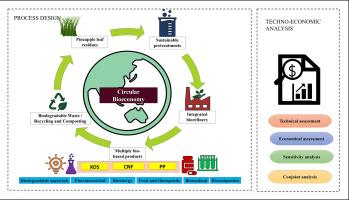综合生物炼制菠萝叶废弃物多种生产方案的技术经济评价
Q1 Environmental Science
引用次数: 0
摘要
菠萝叶等农业残留物是一种丰富但未充分利用的增值资源。本研究评估了一种新的单步水热法从菠萝叶废料中生产高价值产品的技术经济可行性。评估了四种情况:(i)纤维素纳米纤维(CNF)、低聚木糖(XOS)和多酚粉末(PP)的回收(CNF + XOS + PP), (ii) CNF + XOS, (iii) CNF + PP, (iv)仅CNF。对于一个每年运行180天的5 TPH电厂(基本情况),CNF + XOS + PP方案产生的净现值(NPV)为1.772亿美元,内部收益率(IRR)为38.3%,投资回收期(PBP)为3.4年。CNF + PP方案实现了更高的盈利能力,净现值为1.965亿美元,内部收益率为40.8%,PBP为2.9年。敏感性分析显示,运行时间和CNF价格是影响最大的因素。多产品方案的可行性明显高于纯cnf生产(净现值5360万美元)。如果CNF的最低销售价格(MSP)超过32.8美元/公斤,仅CNF的情况仍然有利可图。盈亏平衡分析表明,在CNF + XOS + PP方案中,CNF和XOS的MSPs均为20美元/公斤,而在CNF + PP方案中,CNF和XOS的MSPs分别为30美元/公斤(CNF)和15美元/公斤(PP)。总体而言,研究结果强调,综合农业废物生物精炼厂为可持续产品开发和废物增值提供了强大的技术和经济潜力。本文章由计算机程序翻译,如有差异,请以英文原文为准。

Techno-economic evaluation of multiple product scenarios from pineapple leaf waste in integrated biorefinery
Agricultural residues such as pineapple leaves represent an abundant yet underutilized resource for value addition. This study assesses the techno-economic feasibility of producing high-value products from pineapple leaf waste through a novel single-step hydrothermal process. Four scenarios were evaluated: (i) recovery of cellulose nanofibers (CNF), xylooligosaccharides (XOS), and polyphenol powder (PP) (CNF + XOS + PP), (ii) CNF + XOS, (iii) CNF + PP, and (iv) CNF only. For a 5 TPH plant operating 180 days annually (base case), the CNF + XOS + PP scenario yielded a net present value (NPV) of US$177.2 million, an internal rate of return (IRR) of 38.3 %, and a payback period (PBP) of 3.4 years. The CNF + PP scenario achieved even higher profitability with an NPV of US$196.5 million, an IRR of 40.8 %, and a PBP of 2.9 years. Sensitivity analysis revealed that operational duration and CNF price are the most influential factors. Multiproduct scenarios demonstrated significantly higher viability than CNF-only production (NPV US$53.6 million). The CNF-only case remains profitable if the minimum selling price (MSP) of CNF exceeds US$32.8/kg. Breakeven analysis indicated MSPs of US$20/kg for both CNF and XOS in the CNF + XOS + PP scenario, and US$30/kg (CNF) and US$15/kg (PP) in the CNF + PP scenario. Overall, the findings highlight that integrated agri-waste biorefineries offer strong technical and economic potential for sustainable product development and waste valorization.
求助全文
通过发布文献求助,成功后即可免费获取论文全文。
去求助
来源期刊

Bioresource Technology Reports
Environmental Science-Environmental Engineering
CiteScore
7.20
自引率
0.00%
发文量
390
审稿时长
28 days
 求助内容:
求助内容: 应助结果提醒方式:
应助结果提醒方式:


